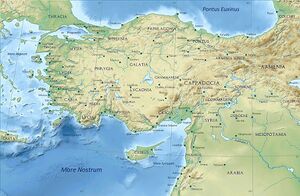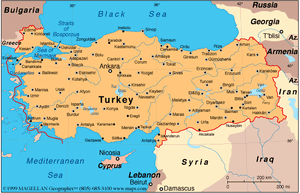Sivas
| Author:Laxman Burdak, IFS (R) |


Sivas is a city in central Turkey and the seat of Sivas Province.
Variants
- Sebastia (Pliny.vi.3)
- Latin and Greek: Sebastia, Sebastea, Σεβάστεια, Σεβαστή,[1]
- Armenian: Սեբաստիա, romanized: Sebastia[2])[3]
- Byzantine Greek name Sivasteia[4]
- Koine Greek name Sebasteia (Σεβαστεία).[5]
Jat clans
- Siwas
- Sivaj
- Sivas = Sibis became known as Shivakhande or Sheokhande.[7]
Name
The name of the city is a truncated form of its Byzantine Greek name Sivasteia[8] from the Koine Greek name Sebasteia (Σεβαστεία), meaning that it was named in honour of an emperor using the title Sebastos, the Greek equivalent of Augustus.[9]
In Kurdish it is called Sêwas.[10]
Geography
The city, which lies at an elevation of 1,278 metres (4,193 ft) in the broad valley of the Kızılırmak river, is a moderately-sized trade centre and industrial city, although the economy has traditionally been based on agriculture. Rail repair shops and a thriving manufacturing industry of rugs, bricks, cement, and cotton and woolen textiles form the mainstays of the city's economy. The surrounding region is a cereal-producing area with large deposits of iron ore which are worked at Divriği.
Sivas is also a communications hub for the north–south and east–west trade routes to Iraq and Iran, respectively. With the development of railways, the city gained new economic importance as junction of important rail lines linking the cities of Ankara, Kayseri, Samsun, and Erzurum. The city is linked by air to Istanbul.
The popular name Sebastian derives from Sebastianòs, Σεβαστιανός, meaning someone from the city.[11][12]
History
Little is known of Sivas' history prior to its emergence in the Roman period. In 64 BC, as part of his reorganization of Asia Minor after the Third Mithridatic War, Pompey the Great founded a city on the site called "Megalopolis".[13] Numismatic evidence suggests that Megalopolis changed its name in the last years of the 1st century BC to "Sebaste", the feminine form Sebastos, the Greek equivalent of Augustus.
The name "Sivas" is the Turkish version deriving from the name Sebasteia, as the city was known during the late Roman (Byzantine) empire. Sebasteia became the capital of the province of Armenia Minor under the emperor Diocletian, was a town of some importance in the early history of the Christian Church; in the 4th century it was the home of Saint Blaise and Saint Peter of Sebaste, bishops of the town, and of Eustathius, one of the early founders of monasticism in Asia Minor. It was also the place of martyrdom of the Forty Martyrs of Sebaste, also 4th century. Justinian I had a fortified wall around it rebuilt in the 6th century. In the early 1020s, Basil II delivered the region around Sebasteia in exchange for Vaspurakan to King Seneqerim Ardzruni, who settled in Sebasteia with thousands of his Armenian followers.[14]
Sebasteia was the first important city to be plundered by Turkish tribes in 1059.[15] In August of that year the troops of various emirs gathered before the unwalled city. Initially they hesitated to sack it, mistaking the domes of the city's several Christian churches for tents of military camps. As soon as they realized that the city was defenceless they burned it for eight days, slaughtered a large part of its population and took many prisoners.[16] The city came under the domain of Turkmen Danishmend dynasty (1071–1174) after the Battle of Manzikert in 1071. After the death of Danişmend Gazi, Sivas passed to Nizamettin Yağıbasan who won it after a struggle with Danişmend Gazi's successors. In 1174, the city was captured by Seljuk ruler Kilij Arslan II and periodically served as capital of the Seljuk empire along with Konya. Under Seljuk rule, Sivas was an important center of trade along the silk road and site of a citadel, along with mosques and madrasas (Islamic educational institutions), four of which survive today and one of which houses the Sivas Museum. Then it passed to the Ilkhanids, Eretna and Kadı Burhanettin.
Jat History
The Shokeen or Shivakhande clan: Hukum Singh Panwar (Pauria)[17] writes... It may, however, be interesting to note that a Jat tribe, living in about 25 contiguous villages in Jind district of Haryana and about 5 villages in Nangloi block of Delhi , goes by its gotra name as Shivakhande or Sheokhand. of late this gotra has been Arabicised as Shokeen in Delhi villages. Yet the elders of Sheokhand Khap area take pride in the fact that they originally hail from the Dharans, whose kingdom was rather misnomered as "Gupta empire" in Indian history. Be that as it may, one thing is plausible about the Jats of Sheokhande clan. They must be the Sivas who fought against the Bharatas on the Jamuna River in one of the ten Rigvedic wars. They are identified by scholars with the Shivis[18] or the Sibis of the Usinara country in the north of Haridwar near the source of Ganges.[19] The Sivas or Sibis became known as Shivakhande or Sheokhande from and after the Shivaliks, the abode of Lord Shiva, the highest deity of the Jats. Their descent from the Shivalik hills has provided good grounds to the author of Devasamhita to expound this account.
Economy
Historically, Sivas was known for producing cereal.
Mention by Pliny
Pliny[20] mentions...Cappadocia1 has in the interior Archelais,2 a colony founded by Claudius Cæsar, and past which the river Halys flows; also the towns of Comana,3 watered by the Sarus, Neocæsarea,4 by the Lycus,5 and Amasia,6 in the region of Gazacene, washed by the Iris. In Colopene it has Sebastia and Sebastopolis;7 these are insignificant places, but still equal in importance to those just mentioned.
1 The boundaries of Cappadocia varied under the dominion of the Persians, after the Macedonian conquest, and as a Roman province under the emperors.
2 Founded by Archelaüs, the last king of Cappadocia. In Hamilton's Researches, the site has been assumed to be the modern Ak-serai, but that place is not on the river Halys, as Leake supposes. It is, however, considered that Ak-serai agrees very well with the position of Archelais as laid down in the Itineraries, and that Pliny may have been misled in supposing that the stream on which it stood was the Halys.
3 Also called by the name of Chryse, or "Golden," to distinguish it from another place of the same name in Pontus. It is generally supposed that the town of Al-Bostan, on the Sihoon or Sarus, is on or near the site of this Comana.
4 Now called Niksar, according to D'Anville, though Hardouin says that it is Tocat. Parisot remarks, that this place belonged rather to Pontus than to Cappadocia.
5 A small tributary of the Iris, or Yeshil-Irmak, mentioned in the next Chapter.
6 Both to the west of Neo-Cæsarea. According to Tavernier, as quoted by Hardouin, the modern name of Sebastia is Sivas.
7 Still called Amasia, or Amasiyeh, and situate on the river Iris, or Yeshil Ermak. It was at one time the residence of the princes of Pontus, and the birth-place of the geographer Strabo. The remains of antiquity here are very considerable, and extremely interesting.
References
- ↑ ulia Cresswell (5 November 2007). Naming Your Baby: The Definitive Dictionary of First Names. A&C Black. p. 209. ISBN 978-0-7136-8313-4.
- ↑ Marsoobian, Armen T. (2015). Fragments of a Lost Homeland: Remembering Armenia. London: I. B. Taurus. p. 56. ISBN 9781784532116.
- ↑ ulia Cresswell (5 November 2007). Naming Your Baby: The Definitive Dictionary of First Names. A&C Black. p. 209. ISBN 978-0-7136-8313-4.
- ↑ Lindsey, James E.; Mourad, Suleiman A., eds. (2021-10-06). Muslim Sources of the Crusader Period: An Anthology. Hackett Publishing. p. 147.
- ↑ Julia Cresswell (5 November 2007). Naming Your Baby: The Definitive Dictionary of First Names. A&C Black. p. 209. ISBN 978-0-7136-8313-4.
- ↑ Avcýkýran, Dr. Adem (ed.). "Kürtçe Anamnez, Anamneza bi Kurmancî" (PDF). Tirsik. p. 57.
- ↑ Hukum Singh Panwar (Pauria): The Jats - Their Origin, Antiquity & Migrations, Rohtak, 1993. ISBN 81-85235-22-8, p. 38
- ↑ Lindsey, James E.; Mourad, Suleiman A., eds. (2021-10-06). Muslim Sources of the Crusader Period: An Anthology. Hackett Publishing. p. 147.
- ↑ Julia Cresswell (5 November 2007). Naming Your Baby: The Definitive Dictionary of First Names. A&C Black. p. 209. ISBN 978-0-7136-8313-4.
- ↑ Avcýkýran, Dr. Adem (ed.). "Kürtçe Anamnez, Anamneza bi Kurmancî" (PDF). Tirsik. p. 57.
- ↑ ulia Cresswell (5 November 2007). Naming Your Baby: The Definitive Dictionary of First Names. A&C Black. p. 209. ISBN 978-0-7136-8313-4.
- ↑ Davis, J. Madison (1995). The Shakespeare Name and Place Dictionary. Routledge. p. 444. ISBN 978-1-884964-17-6.
- ↑ A.H.M. Jones, The Cities of the Eastern Roman Provinces, 2nd ed. (Oxford University Press, 1971), 159.
- ↑ Krikorian, Mesrob K. (1977-01-01). Armenians in the Service of the Ottoman Empire, 1860-1908. Routledge and Kegan Paul. p. 53. ISBN 9781138492073.
- ↑ Rosser, John H. (2012). Historical dictionary of Byzantium (2nd ed.). Lanham, Maryland: Scarecrow Press. p. 425. ISBN 9780810875678.
- ↑ Speros Vryonis, The Decline of Medieval Hellenism in Asia Minor and the Process of Islamization from the Eleventh through the Fifteenth Century (University of California Press, 1971), p. 155
- ↑ Hukum Singh Panwar (Pauria): The Jats - Their Origin, Antiquity & Migrations, Rohtak, 1993. ISBN 81-85235-22-8, p. 38
- ↑ Kathasaritsagar, vol.1 p. 11
- ↑ ABORI, vol. XXIX, p. 117, fn. 9
- ↑ [Natural History by Pliny Book VI/Chapter 3]]
Back to Jat Places in Turkey

